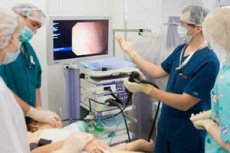Medical expert of the article
New publications
Sigmoscopy
Last reviewed: 03.07.2025

All iLive content is medically reviewed or fact checked to ensure as much factual accuracy as possible.
We have strict sourcing guidelines and only link to reputable media sites, academic research institutions and, whenever possible, medically peer reviewed studies. Note that the numbers in parentheses ([1], [2], etc.) are clickable links to these studies.
If you feel that any of our content is inaccurate, out-of-date, or otherwise questionable, please select it and press Ctrl + Enter.

Sigmoidoscopy, sigmoidoscopy or rectosigmoscopy is an instrumental method of examining the final part of the main section of the large intestine, the sigmoid colon (colon sigmoideum), which passes directly into the rectum.
What is this procedure? This is a diagnostic procedure: with its help, gastroenterologists and proctologists diagnose intestinal diseases by examining the mucous membrane lining the sigmoid and rectum from the inside with a fiber-optic endoscopic device (sigmoidoscope).
Indications for the procedure
Complaints of frequent pain in the abdomen, left side, iliac and/or inguinal region; bloating and heaviness in the abdominal cavity; constipation or diarrhea (indicating intestinal peristalsis disorders); attacks of vomiting with bile or the presence of blood in the stool are indications for sigmoidoscopy to determine the cause of the pathology.
This method of examining the sigmoid colon helps the doctor identify or confirm:
- chronic non-ulcerative colitis of the segmental type in the form of inflammation of the sigmoid colon (sigmoiditis) or inflammation of the sigmoid and rectum (proctosigmoiditis);
- ulcerative colitis and Crohn's disease;
- adenocarcinoma of the sigmoid colon; [ 1 ]
- anatomical anomaly in the form of dolichosigma;
- polyps and diverticula of the colon.
Sigmoidoscopy is used as one of the methods for diagnosing hemorrhoids and a method for screening colorectal cancer – rectal adenocarcinoma.
In addition, sigmoidoscopy is used to take a sample of intestinal wall tissue (biopsy), in endoscopic surgical interventions on the colon (for example, to remove polyps), and in emergency care in cases of sigmoid volvulus (a form of acute intestinal obstruction) - for its endoscopic detorsion. [ 2 ]
When using such endoscopic examination methods as sigmoidoscopy and rectoscopy, the differences are that rectoscopy (or rectoscopy) allows visualization of the internal surface of the rectum and only a small part of the sigmoid colon passing into it through the sigmo-rectal sphincter, which is curved in the shape of the Greek letter sigma (similar to "s"). The rectoscope tube is not inserted further, and only sigmoidoscopy with a flexible endoscope allows visualization of the sigmoid colon along its entire length - to the descending colon (colon descendens) and the distal sphincter.
Preparation
Before any endoscopic examination of the intestine, the preparation is the same: three to four days before the scheduled procedure, you should limit the intake of food containing fiber and plant fibers; 12 hours before the examination, you should drink only water and be sure to cleanse the colon with an enema and/or laxatives (oral or in the form of rectal suppositories).
Technique sigmoscopies
To perform the procedure, the patient is placed on the left side, since the localization of the sigmoid colon is the left iliac fossa (fossa iliaca). After palpation of the rectum, a flexible sigmoidoscope is inserted through the anus (the maximum depth is about 60 cm).
To expand the lumen of the intestine and provide a clear image on the monitor (transmitted from the endoscope camera), air is injected into the intestine using a balloon (insufflation).
During the procedure, a tissue sample may be taken for histological examination.[ 3 ]
On average, sigmoidoscopy lasts no longer than 20 minutes.
Contraindications to the procedure
Among the main contraindications to sigmoidoscopy, experts note:
- unconscious state;
- myocardial infarction and post-infarction state;
- acute or severe cardiopulmonary failure;
- acute and subacute stages of colitis;
- presence of anal fissure;
- large abdominal hernia;
- intestinal bleeding;
- intestinal perforation or peritonitis, which may present clinically as dark, tarry stools (melena) associated with gastrointestinal bleeding;
- patients undergoing outpatient peritoneal dialysis.
Complications after the procedure
The consequences of this procedure are short-term watery stools, gas discharge from the intestines, intestinal spasms (with minor painful sensations). However, in the active stage of intestinal inflammation, severe pain is possible. [ 4 ]
The procedure of endoscopic examination of the sigmoid (and rectal) colon may have complications such as:
- bleeding of varying intensity (especially during biopsy);
- perforation or rupture of the intestinal wall mucosa.
- severe pain in the abdominal cavity.
Reviews
In addition to purely emotional reviews of sigmoidoscopy as an unpleasant procedure, most patients note discomfort that they felt both during the examination and for a short period of time after it. But, as studies have shown, it is with the help of this examination that up to 60-75% of all precancerous or small malignant neoplasms of the colon can be detected.

